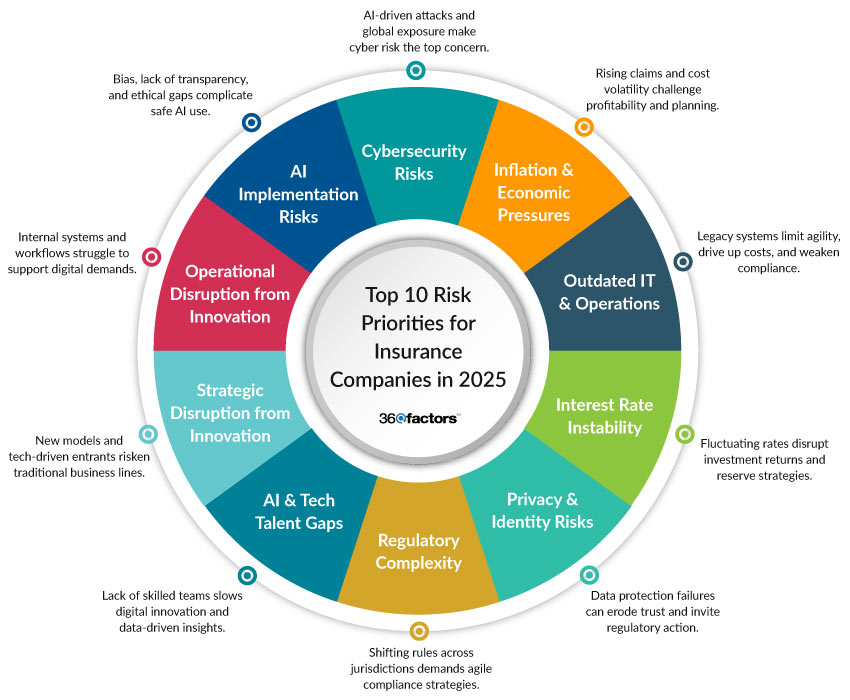Home/ Blog / How 2025’s Top Risks Are Reshaping Risk Management in Insurance Companies
Risk awareness has reached a new peak for the insurance industry in 2025. Insurers operate in a competitive landscape of accelerated digital transformation, geopolitical uncertainty, and rising regulatory expectations. The risks they face today are no longer isolated or static; they are interconnected, fast-moving, and increasingly systemic.
What’s emerging is a clear shift in the risk landscape: from traditional actuarial and operational concerns to broader, more complex risks that span cybersecurity, macroeconomic instability, and internal infrastructure limitations. Cybercrime, inflation, insurance regulatory compliance, and AI governance are no longer fringe topics; they sit at the heart of boardroom agendas.
For risk management in insurance companies, this shift demands more than periodic risk reviews or manual mitigation efforts. It requires rethinking how risks are identified, assessed, and acted upon across the enterprise. Legacy systems and siloed processes are being replaced by agile, real-time frameworks that enable faster decisions and stronger resilience.
This blog explores the ten most pressing risks shaping the insurance sector in 2025 and how smarter, more integrated risk management software can empower insurers to navigate uncertainty confidently and clearly.
2025’s Most Pressing Risks for Insurance Companies

1. Cybersecurity Risks
According to a recent survey of insurance companies, cybersecurity remains the top-ranked risk for the sector in 2025, and for good reasons. Risks have become more systemic, fast-evolving, and challenging to model with actuarial precision, and cybersecurity is now central to effective risk management in insurance companies. Insurers are increasingly concerned about aggregating global cyber exposures, particularly as AI-powered cybercrime becomes more sophisticated and less predictable.
The convergence of cyber and privacy risks has prompted the rise of “fusion centers,” cross-functional hubs for detecting and managing digital risks in real-time. Still, many insurers struggle with underdeveloped cybersecurity frameworks, limited visibility across their digital ecosystem, and high dependency on third-party providers. The inability to underwrite cyber risks accurately compounds the challenge, making cybersecurity a persistent blind spot in operational and product strategies.
2. Economic Conditions and Inflation
Inflationary pressures remain a top concern, directly affecting insurers’ profitability, underwriting assumptions, and reserve management. As part of broader risk management in insurance companies, navigating inflation requires careful adjustments to pricing models, capital allocation, and long-term liability planning. Higher claims costs, elevated wage expectations, and tightening reinsurance markets squeeze margins and create uncertainty around long-term liability pricing.
To overcome these challenges, insurers are adopting more conservative investment strategies, reallocating capital, and revisiting pricing models to maintain solvency & risk management. However, these economic pressures also increase friction across product development, distribution, and capital planning. Inaccurate inflation risk forecasting can erode competitive positioning and expose insurers to cumulative financial risk.
3. Legacy IT and Operational Infrastructure
Aging systems continue to undermine risk agility across the insurance sector. Modernizing core systems is essential for effective risk management in insurance companies, yet many insurers remain burdened by outdated infrastructure. Legacy infrastructure slows compliance reporting, inhibits automation, and limits an insurer’s ability to deliver seamless customer experiences. These systems also struggle to scale in response to emerging digital initiatives, compounding operational costs and maintenance burdens.
“Technical debt” has become central to risk management strategy conversations. As insurers fall behind in modernizing their platforms, they not only miss innovation opportunities but also increase their vulnerability to data breaches, regulatory penalties, and competitive displacement.
4. Interest Rate Volatility
While higher interest rates can improve investment returns, rate volatility introduces substantial risk, especially for life and annuity lines. For effective risk management in insurance companies, managing interest rate exposures has become a priority, as mismatches between product guarantees and portfolio performance can lead to material losses, particularly when policyholder behavior shifts in response to changing market conditions.
The pressure to manage capital buffers in volatile rate environments also affects everything from product pricing to reserve planning. Risk modeling becomes more complex, requiring faster scenario analysis and stress testing to manage interest rate exposures proactively.
5. Privacy and Identity Protection
With the expansion of digital services, insurers are collecting and managing more personal and sensitive data than ever. This heightens the operational and compliance burden around data privacy, consent, and identity protection. Regulators around the globe continue to raise expectations, requiring insurers to demonstrate control, maturity, and accountability in data governance.
Identity protection is no longer just a cybersecurity issue; it’s a core compliance requirement and imperative to customer trust. Failure to secure personally identifiable information (PII) can result in financial penalties and long-term reputational damage.
6. Regulatory Uncertainty and Scrutiny
Insurance industry regulations remain relentless, especially across multiple jurisdictions. From consumer data rights to ESG disclosures and algorithmic accountability, insurers must monitor, interpret, and comply with an expanding set of requirements. Relying on static compliance frameworks and periodic reviews is no longer sufficient for robust risk management in insurance companies.
The challenge lies in dynamically monitoring regulatory shifts and operationalizing compliance at scale. The ability to interpret legal changes, assess policy impact, and communicate with stakeholders is becoming a strategic differentiator in regulatory risk management.
7. AI and Tech Talent Shortage
Insurers are investing heavily in AI, machine learning, and advanced analytics, but talent remains in short supply. A limited pool of skilled professionals hinders innovation in underwriting, pricing, risk detection, and claims optimization.
As competition intensifies data scientists and AI architects, insurers struggle to embed these capabilities into day-to-day operations. Without the talent to design, manage, and audit AI tools, technology investments may fall short of delivering meaningful impact, or worse, introduce new risks.
8. Disruptive Innovation and Market Shifts – Strategic
The pace of innovation across the insurance value chain is accelerating. Digital-first customer expectations, real-time underwriting, and embedded insurance models reshape market dynamics. At the same time, insurtechs and other tech-driven businesses are raising the bar for speed, personalization, and platform-based distribution.
For effective risk management in insurance companies, organizations must adapt to this evolving landscape by institutionalizing a strategic transformation mindset. Traditional insurers face growing pressure to modernize their business models while protecting their existing market share. The risk lies in delayed innovation and a lack of foresight in identifying strategic disruptions before they take hold.
9. Disruptive Innovation – Operational
Innovation doesn’t just disrupt strategy; it challenges internal operations. Core business processes, data systems, and risk controls must evolve to support new products, channels, and digital experiences. However, transformation initiatives often expose process inefficiencies and introduce execution risks.
Insurers must align innovation with operational readiness. Agile teams, modular platforms, and cross-functional integration are essential to managing the operational impact of continuous change.
10. Risks from Implementing AI
Adoption of AI in the insurance industry offers significant opportunities but also introduces a complex new class of risks from biased algorithms and a lack of explainability to broader systemic and ethical concerns. In highly regulated environments, risk management in insurance companies must now account for not only what AI systems do but also how and why they make decisions.
This shift demands new governance frameworks, robust risk assessment models, and proactive regulatory engagement. Insurers must continuously monitor unintended consequences, ensure transparency in AI-driven processes, and align technology deployments with both business objectives and public expectations.
Implementing a Strategic Risk Management Strategy
The diverse and fast-evolving risks reshaping insurance in 2025 require a fundamental shift in managing risk across the enterprise. Siloed systems, fragmented data, and manual tracking no longer offer the responsiveness or scale needed to address today’s challenges. A unified, agile strategy of risk management in insurance companies is necessary when dealing with cyber risks, economic volatility, or regulatory change.
Modern risk operations must be built on real-time visibility and seamless collaboration. This means integrating risk data across functions, aligning risk appetite with business decisions, and enabling faster detection and response through embedded intelligence and automation.
Implement Insurance Risk Management Software to Manage 2025 Risks
Risk management in 2025 requires more than traditional oversight. The scope, scale, and speed of today’s risk environment, which spans cybersecurity, macroeconomic uncertainty, regulatory volatility, and digital disruption, demands a more innovative, unified approach to enterprise risk management.
Insurers must move beyond manual processes and fragmented systems toward intelligent, integrated solutions that provide real-time visibility and cross-functional collaboration. This is where Predict360 Insurance Risk Management Software offers a strategic advantage. It provides specialized risk management modules tailored for insurance companies, enabling them to identify emerging risks early and take proactive steps to mitigate potential issues. These modules include:
Here’s how the enterprise risk management module supports insurers in managing the top 10 risks of 2025:
Cybersecurity Risks: Real-time monitoring, centralized dashboards, and risk data integration improve cyber risk visibility and the escalation process.
Economic Conditions & Inflation: Integration with Power BI enables scenario analysis and visualization of financial exposures and macroeconomic impacts.
Legacy IT Infrastructure: Predict360 cloud-native, modular design reduces reliance on aging platforms and supports system modernization.
Interest Rate Volatility: Centralized risk repositories and automated updates help insurers track sensitive, interest-based exposures and stress-test rate adjustment assumptions.
Privacy & Identity Protection: Regulatory coverage (e.g., SOX, FATCA, BSA/AML) and automated documentation support compliance with evolving data protection laws.
Regulatory Uncertainty: AI-assisted interpretation of legal language and dynamic risk libraries streamline compliance with shifting regulatory expectations.
AI and Tech Talent Shortage: Intuitive AI companion Kaia, with NLP, simplifies workflows, enabling organization-wide adoption, minimizing the need for additional expert resources.
Strategic Disruption: Standardized risk taxonomies for the insurance sector support proactive risk alignment and response planning.
Operational Disruption: Cross-functional collaboration tools and centralized oversight improve process resilience and issue resolution.
AI Implementation Risks: Real-time visibility, structured risk assessments, and automated controls tailored to evolving AI risks and regulatory requirements.
Request a Demo
Complete the form below and our business team will be in touch to schedule a product demo.
By clicking ‘SUBMIT’ you agree to our Privacy Policy.



